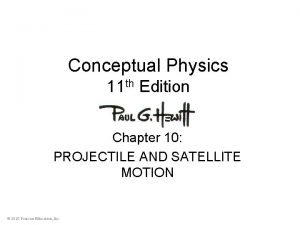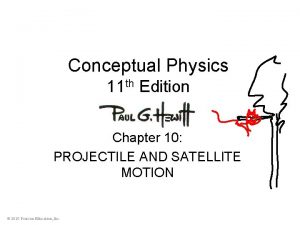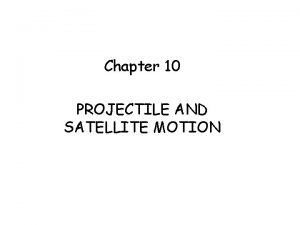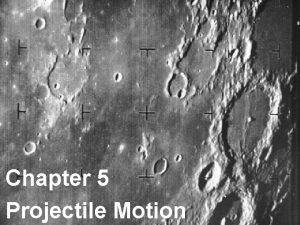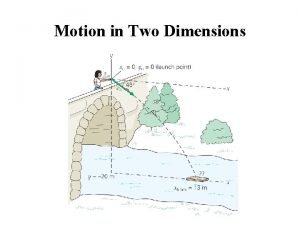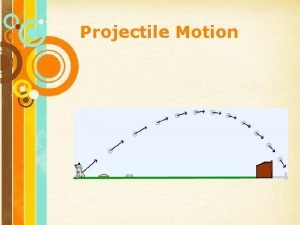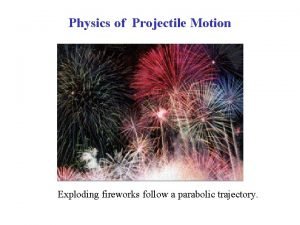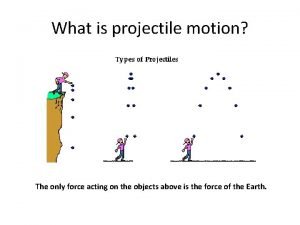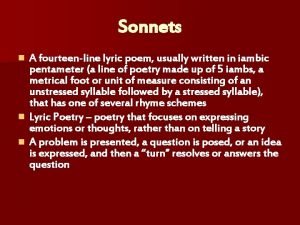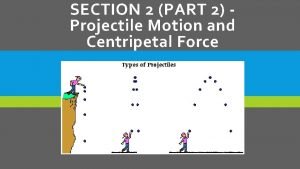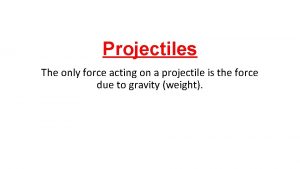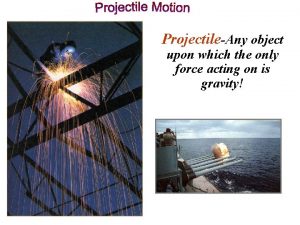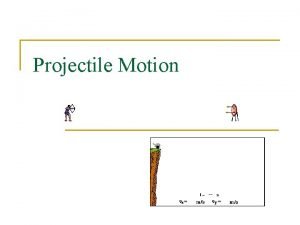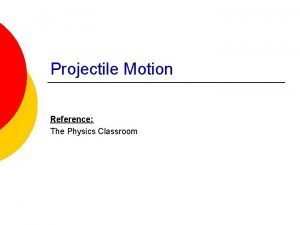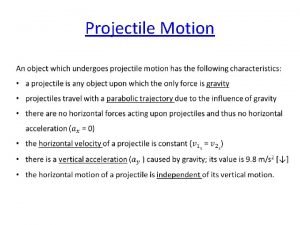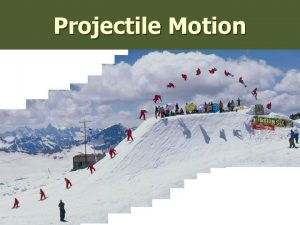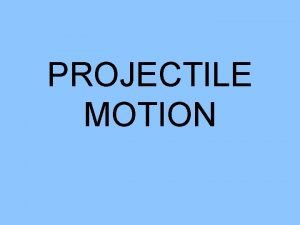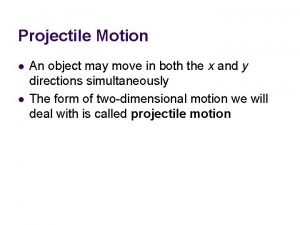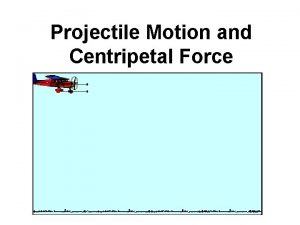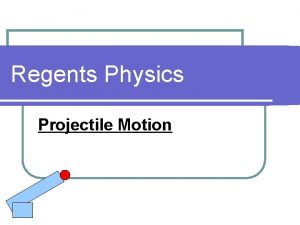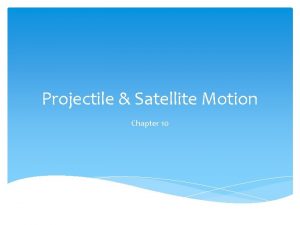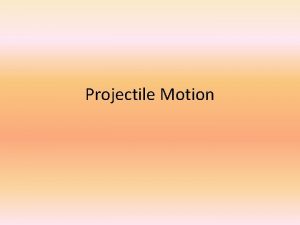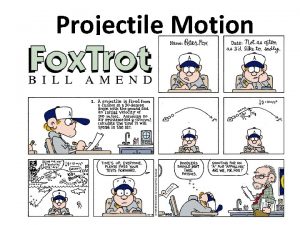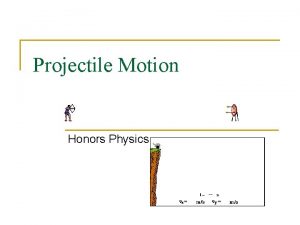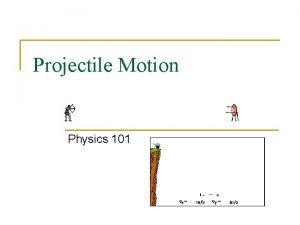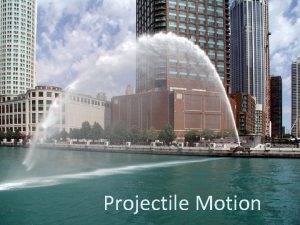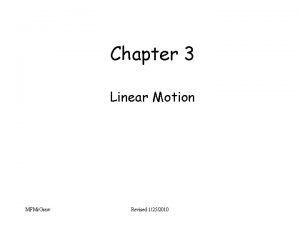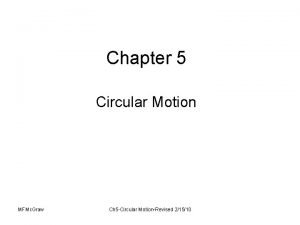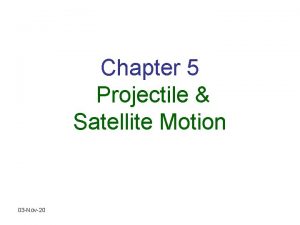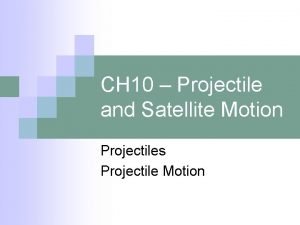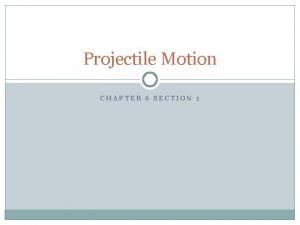Chapter 10 PROJECTILE AND SATELLITE MOTION MFMc Graw














































- Slides: 46

Chapter 10 PROJECTILE AND SATELLITE MOTION MFMc. Graw Chap 10 -Projectile-Revised: 3/7/2010 1

This lecture will help you understand: • • MFMc. Graw Projectile Motion Fast-Moving Projectiles – Satellites Circular Satellite Orbits Elliptical Orbits Kepler’s Laws of Planetary Motion Energy Conservation and Satellite Motion Escape Speed Chap 10 -Projectile-Revised: 3/7/2010 2

Projectile Motion • Without gravity, a tossed object follows a straightline path. • With gravity, the same object tossed at an angle follows a curved path. Projectile: • Any object that moves through the air or space under the influence of gravity, continuing in motion by its own inertia MFMc. Graw Chap 10 -Projectile-Revised: 3/7/2010 3

Projectile Motion Projectile motion is a combination of • a horizontal component, and • a vertical component. MFMc. Graw Chap 10 -Projectile-Revised: 3/7/2010 4

Projectile Motion Projectiles launched horizontally Important points: Horizontal component of velocity doesn’t change (when air drag is negligible). • Ball travels the same horizontal distance in equal times (no component of gravitational force acting horizontally). • Remains constant. MFMc. Graw Chap 10 -Projectile-Revised: 3/7/2010 5

Projectile Motion • Vertical positions become farther apart with time. – Gravity acts downward, so ball accelerates downward. • Curvature of path is the combination of horizontal and vertical components of motion. MFMc. Graw Chap 10 -Projectile-Revised: 3/7/2010 6

Projectile Motion Parabola: • Curved path of a projectile that undergoes acceleration only in the vertical direction, while moving horizontally at a constant speed MFMc. Graw Chap 10 -Projectile-Revised: 3/7/2010 7

Projectile Motion Projectiles launched at an angle: • Paths of stone thrown at an angle upward and downward – Vertical and horizontal components are independent of each other. MFMc. Graw Chap 10 -Projectile-Revised: 3/7/2010 8

Projectile Motion • Paths of a cannonball shot at an upward angle – Vertical distance that a stone falls is the same vertical distance it would have fallen if it had been dropped from rest and been falling for the same amount of time (5 t 2). MFMc. Graw Chap 10 -Projectile-Revised: 3/7/2010 9

Projectile Motion • Paths of projectile following a parabolic trajectory – Horizontal component along trajectory remains unchanged. – Only vertical component changes. – Velocity at any point is computed with the Pythagorean theorem (diagonal of rectangle). MFMc. Graw Chap 10 -Projectile-Revised: 3/7/2010 10

Projectile Motion • Different horizontal distances – Same range is obtained from two different launching angles when the angles add up to 90°. • Object thrown at an angle of 60 has the same range as if it were thrown at an angle of 30. MFMc. Graw Chap 10 -Projectile-Revised: 3/7/2010 11

Projectile Motion Different horizontal distances (continued) – Maximum range occurs for ideal launch at 45. – With air resistance, the maximum range occurs for a baseball batted at less than 45 above the horizontal. – With air resistance the maximum range occurs when a golf ball is hit at an angle less than 38. MFMc. Graw Chap 10 -Projectile-Revised: 3/7/2010 12

Projectile Motion Without air resistance, the time for a projectile to reach maximum height is the same as the time for it to return to its initial level. MFMc. Graw Chap 10 -Projectile-Revised: 3/7/2010 13

Projectile Motion CHECK YOUR NEIGHBOR The velocity of a typical projectile can be represented by horizontal and vertical components. Assuming negligible air resistance, the horizontal component along the path of the projectile • B. C. D. increases. decreases. remains the same. Not enough information. MFMc. Graw Chap 10 -Projectile-Revised: 3/7/2010 14

Projectile Motion CHECK YOUR ANSWER The velocity of a typical projectile can be represented by horizontal and vertical components. Assuming negligible air resistance, the horizontal component along the path of the projectile • B. C. D. increases. decreases. remains the same. Not enough information. Explanation: Since there is no force horizontally, no horizontal acceleration occurs. MFMc. Graw Chap 10 -Projectile-Revised: 3/7/2010 15

Projectile Motion CHECK YOUR NEIGHBOR When no air resistance acts on a fast-moving baseball, its acceleration is • B. C. D. downward, g. a combination of constant horizontal motion and accelerated downward motion. opposite to the force of gravity. centripetal. MFMc. Graw Chap 10 -Projectile-Revised: 3/7/2010 16

Projectile Motion CHECK YOUR ANSWER When no air resistance acts on a fast-moving baseball, its acceleration is • B. C. D. downward, g. a combination of constant horizontal motion and accelerated downward motion. opposite to the force of gravity. centripetal. MFMc. Graw Chap 10 -Projectile-Revised: 3/7/2010 17

Projectile Motion CHECK YOUR NEIGHBOR Neglecting air drag, a ball tossed at an angle of 30 with the horizontal will go as far downrange as one that is tossed at the same speed at an angle of • B. C. D. 45. 60. 75. None of the above. MFMc. Graw Chap 10 -Projectile-Revised: 3/7/2010 18

Projectile Motion CHECK YOUR ANSWER Neglecting air drag, a ball tossed at an angle of 30 with the horizontal will go as far downrange as one that is tossed at the same speed at an angle of • B. C. D. 45. 60. 75. None of the above. Explanation: Same initial-speed projectiles have the same range when their launching angles add up to 90. Why this is true involves a bit of trigonometry—which, in the interest of time, we’ll not pursue here. MFMc. Graw Chap 10 -Projectile-Revised: 3/7/2010 19

Fast-Moving Projectiles— Satellites • Satellite motion is an example of a high-speed projectile. • A satellite is simply a projectile that falls around Earth rather than into it. – Sufficient tangential velocity needed for orbit. – With no resistance to reduce speed, a satellite goes around Earth indefinitely. MFMc. Graw Chap 10 -Projectile-Revised: 3/7/2010 20

Fast-Moving Projectiles—Satellites CHECK YOUR NEIGHBOR As the ball leaves the girl’s hand, 1 second later it will have fallen • B. C. D. 10 meters. 5 meters below the dashed line. less than 5 meters below the straight-line path. None of the above. MFMc. Graw Chap 10 -Projectile-Revised: 3/7/2010 21

Fast-Moving Projectiles—Satellites CHECK YOUR ANSWER As the ball leaves the girl’s hand, 1 second later it will have fallen • B. C. D. 10 meters. 5 meters below the dashed line. less than 5 meters below the straight-line path. None of the above. Comment: Whatever the speed, the ball will fall a vertical distance of 5 meters below the dashed line. MFMc. Graw Chap 10 -Projectile-Revised: 3/7/2010 22

Circular Satellite Orbits Satellite in circular orbit • Speed – must be great enough to ensure that its falling distance matches Earth’s curvature. – is constant—only direction changes. – is unchanged by gravity. MFMc. Graw Chap 10 -Projectile-Revised: 3/7/2010 23

Circular Satellite Orbits • Positioning: beyond Earth’s atmosphere, where air resistance is almost totally absent Example: Space shuttles are launched to altitudes of 150 kilometers or more, to be above air drag (But even the ISS, as shown experiences some air drag, which is compensated for with periodic upward boosts. ) MFMc. Graw Chap 10 -Projectile-Revised: 3/7/2010 24

Circular Satellite Orbits • Motion moves in a direction perpendicular to the force of gravity acting on it • Period for complete orbit about Earth • for satellites close to Earth—about 90 minutes • for satellites at higher altitudes—longer periods MFMc. Graw Chap 10 -Projectile-Revised: 3/7/2010 25

Circular Satellite Orbits Curvature of Earth • Earth surface drops a vertical distance of 5 meters for every 8000 meters tangent to the surface MFMc. Graw Chap 10 -Projectile-Revised: 3/7/2010 26

Circular Satellite Orbits What speed will allow the ball to clear the gap? MFMc. Graw Chap 10 -Projectile-Revised: 3/7/2010 27

Circular Satellite Orbits CHECK YOUR NEIGHBOR When you toss a projectile sideways, it curves as it falls. It will be an Earth satellite if the curve it makes • B. C. D. matches the curved surface of Earth. results in a straight line. spirals out indefinitely. None of the above. MFMc. Graw Chap 10 -Projectile-Revised: 3/7/2010 28

Circular Satellite Orbits CHECK YOUR ANSWER When you toss a projectile sideways, it curves as it falls. It will be an Earth satellite if the curve it makes • B. C. D. matches the curved surface of Earth. results in a straight line. spirals out indefinitely. None of the above. Explanation: For an 8 -km tangent, Earth curves downward 5 m. Therefore, a projectile traveling horizontally at 8 km/s will fall 5 m in that time, and follow the curve of Earth. MFMc. Graw Chap 10 -Projectile-Revised: 3/7/2010 29

Circular Satellite Orbits CHECK YOUR NEIGHBOR When a satellite travels at a constant speed, the shape of its path is • B. C. D. a circle. an ellipse. an oval that is almost elliptical. a circle with a square corner, as seen throughout your book. MFMc. Graw Chap 10 -Projectile-Revised: 3/7/2010 30

Circular Satellite Orbits CHECK YOUR ANSWER When a satellite travels at a constant speed, the shape of its path is • B. C. D. a circle. an ellipse. an oval that is almost elliptical. a circle with a square corner, as seen throughout your book. MFMc. Graw Chap 10 -Projectile-Revised: 3/7/2010 31

Circular Satellite Orbits A payload into orbit requires control over • direction of rocket. – Initially, rocket is fired vertically, then tipped. – Once above the atmosphere, the rocket is aimed horizontally. • speed of rocket – Payload is given a final thrust to orbital speed of 8 km/s to fall around Earth and become an Earth satellite. MFMc. Graw Chap 10 -Projectile-Revised: 3/7/2010 32

Elliptical Orbits • A projectile just above the atmosphere will follow an elliptical path if given a horizontal speed greater than 8 km/s. Ellipse • specific curve, an oval path Example: A circle is a special case of an ellipse when its two foci coincide. MFMc. Graw Chap 10 -Projectile-Revised: 3/7/2010 33

Elliptical Orbits Elliptical orbit • Speed of satellite varies. – Initially, if speed is greater than needed for circular orbit, satellite overshoots a circular path and moves away from Earth. – Satellite loses speed and then regains it as it falls back toward Earth. – It rejoins its original path with the same speed it had initially. – Procedure is repeated. MFMc. Graw Chap 10 -Projectile-Revised: 3/7/2010 34

Elliptical Orbits CHECK YOUR NEIGHBOR The speed of a satellite in an elliptical orbit • B. C. D. varies. remains constant. acts at right angles to its motion. All of the above. MFMc. Graw Chap 10 -Projectile-Revised: 3/7/2010 35

Elliptical Orbits CHECK YOUR ANSWER The speed of a satellite in an elliptical orbit • B. C. D. varies. remains constant. acts at right angles to its motion. All of the above. Comment : A satellite in an elliptical orbit half the time recedes from Earth and loses speed and half the time approaches Earth and gains speed. MFMc. Graw Chap 10 -Projectile-Revised: 3/7/2010 36

Kepler’s Laws of Planetary Motion • Kepler was assistant to the famous astronomer Brahe, who directed the world’s first observatory. • He used data his mentor Brahe had collected on planetary motion to figure out the motion of planets. • He found that the motion of planets was not circular; rather, it was elliptical. MFMc. Graw Chap 10 -Projectile-Revised: 3/7/2010 37

Kepler’s Laws of Planetary Motion 1 st Law: The path of each planet around the Sun is an ellipse with the Sun at one focus. 2 nd Law: The line from the Sun to any planet sweeps out equal areas of space in equal time intervals. 3 rd Law: The square of the orbital period of a planet is directly proportional to the cube of the average distance of the planet from the Sun (for all planets). MFMc. Graw Chap 10 -Projectile-Revised: 3/7/2010 38

Energy Conservation and Satellite Motion Recall the following: • Object in motion possesses KE due to its motion. • Object above Earth’s surface possesses PE by virtue of its position. • Satellite in orbit possesses KE and PE. – Sum of KE and PE is constant at all points in the orbit. MFMc. Graw Chap 10 -Projectile-Revised: 3/7/2010 39

Energy Conservation and Satellite Motion PE, KE, and speed in circular orbit: – Unchanged. – distance between the satellite and center of the attracting body does not change—PE is the same everywhere. – no component of force acts along the direction of motion—no change in speed and KE. MFMc. Graw Chap 10 -Projectile-Revised: 3/7/2010 40

Energy Conservation and Satellite Motion Elliptical Orbit Varies. – PE is greatest when the satellite is farthest away (apogee). – PE is least when the satellite is closest (perigee). – KE is least when PE is the most and vice versa. – At every point in the orbit, sum of KE and PE is the same. MFMc. Graw Chap 10 -Projectile-Revised: 3/7/2010 41

Energy Conservation and Satellite Motion When satellite gains altitude and moves against gravitational force, its speed and KE decrease and decrease continues to the apogee. Past the apogee, satellite moves in the same direction as the force component and speed and KE increase. Increase continues until past the perigee and cycle repeats. MFMc. Graw Chap 10 -Projectile-Revised: 3/7/2010 42

Escape Speed First probe to escape the solar system was Pioneer 10, launched from Earth in 1972. • Accomplished by directing the probe into the path of oncoming Jupiter MFMc. Graw Chap 10 -Projectile-Revised: 3/7/2010 43

Escape Speed CHECK YOUR NEIGHBOR When a projectile achieves escape speed from Earth, it • B. C. D. forever leaves Earth’s gravitational field. outruns the influence of Earth’s gravity, but is never beyond it. comes to an eventual stop, returning to Earth at some future time. All of the above. MFMc. Graw Chap 10 -Projectile-Revised: 3/7/2010 44

Escape Speed CHECK YOUR ANSWER When a projectile achieves escape speed from Earth, it • B. C. D. forever leaves Earth’s gravitational field. outruns the influence of Earth’s gravity, but is never beyond it. comes to an eventual stop, returning to Earth at some future time. All of the above. MFMc. Graw Chap 10 -Projectile-Revised: 3/7/2010 45

Escape Speed Voyages to the Moon, Mars, and beyond begin with launches that exceed escape speed from Earth. MFMc. Graw Chap 10 -Projectile-Revised: 3/7/2010 46
 Conceptual physics chapter 10
Conceptual physics chapter 10 Chapter 10 projectile and satellite motion
Chapter 10 projectile and satellite motion Chapter 10 projectile and satellite motion tossed ball
Chapter 10 projectile and satellite motion tossed ball A child sits upright in a wagon which is moving
A child sits upright in a wagon which is moving Which of these expresses a vector quantity
Which of these expresses a vector quantity What is flaw graw
What is flaw graw Operations definition
Operations definition Mardu graw
Mardu graw Graw print
Graw print Monroe's motivated sequence
Monroe's motivated sequence Suzanne graw
Suzanne graw Mc graw hill education
Mc graw hill education Mc graw hill education
Mc graw hill education Mc graw hill education
Mc graw hill education Fuentes del derecho laboral internas y externas
Fuentes del derecho laboral internas y externas Mc graw hill education
Mc graw hill education Mc grawhill
Mc grawhill Gonall
Gonall Mc graw hill
Mc graw hill Flaw graw
Flaw graw Retail positioning matrix
Retail positioning matrix Define graw
Define graw Graw outlet
Graw outlet Projectile motion displacement formula
Projectile motion displacement formula Projectile motion ppt free download
Projectile motion ppt free download Similarity between freefall and projectile motion
Similarity between freefall and projectile motion Chapter 2 motion section 1 describing motion answer key
Chapter 2 motion section 1 describing motion answer key What is acceleration
What is acceleration Section 1 describing motion answer key
Section 1 describing motion answer key Only force acting on a projectile
Only force acting on a projectile Symmetrical projectile motion
Symmetrical projectile motion Acceleration vector projectile motion
Acceleration vector projectile motion It is a 14-line lyric poem with iambic pentameter.
It is a 14-line lyric poem with iambic pentameter. An object in projectile motion will follow which path?
An object in projectile motion will follow which path? What is the only force that acts on a projectile
What is the only force that acts on a projectile An object upon which the only force acting is gravity.
An object upon which the only force acting is gravity. What is a projectile
What is a projectile Physics classroom
Physics classroom Examples of projectile motion
Examples of projectile motion Vertical y horizontal
Vertical y horizontal Which describes an object in projectile motion?
Which describes an object in projectile motion? What is the combination of projectile motion
What is the combination of projectile motion Tennis projectile
Tennis projectile Projectile motion in volleyball
Projectile motion in volleyball What is vyf in physics
What is vyf in physics Maximum height
Maximum height A projectile has a single force that acts upon it
A projectile has a single force that acts upon it
